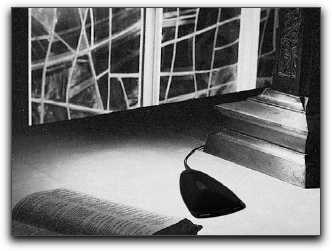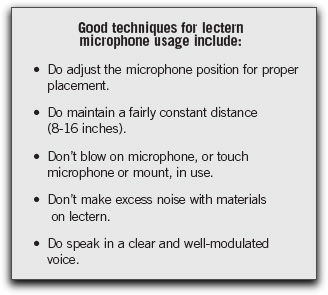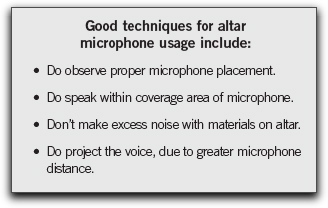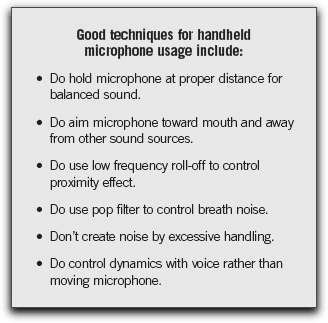|
by Tim Vear
In order to select a microphone for a specific application, it is first necessary to know the important characteristics of the sound source(s) and of the sound system.
Once these are defined, a look at the five areas of microphone specifications previously discussed will lead to an appropriate match.
Finally, correct placement and proper use will insure best performance. In this section, we will present recommendations for some of the most common worship facility sound applications.
The sound system in the following examples is assumed to be of high quality, with balanced low-impedance microphone inputs and available phantom power
Lectern
The desired sound source for a lectern microphone is typically a speaking voice, though one may occasionally be used for singing.
Undesired sound sources that may be present are nearby loudspeakers (possibly a central cluster overhead), and ambient sound (possibly ventilation or traffic noise, and reflected sound).
The basic performance requirements for a lectern microphone can be met by either dynamic or condenser types, so the choice of operating principle is often determined by other factors, such as appearance.
In particular, the desire for an unobtrusive microphone is better satisfied by a condenser design, which can maintain high performance even in very small sizes. Dynamic types are somewhat larger, but they do not require phantom power.
To match the desired sound source (the voice), the microphone must have a frequency response that covers the vocal range (approximately 100Hz to 15kHz). Within that range the response can be flat, if the sound system and the room acoustics are very good; but often a shaped response, with some presence rise, will improve intelligibility. Above 15kHz and below 100 Hz, the response should roll off smoothly, to avoid pickup of noise and other sounds outside of the vocal range, and to control proximity effect.
The choice of microphone directionality that will maximize pickup of the voice, and minimize undesired sounds, is unidirectional. This type will also reduce the likelihood of feedback since it can be aimed toward the talker and away from loudspeakers.
Depending on how much the person speaking may move about, or on how close the microphone can be placed, a particular type may be chosen: a cardioid for moderately broad, close-up coverage; a supercardioid or a hypercardioid for progressively narrower or slightly more distant coverage.
The electrical characteristics of the microphone are primarily determined by the sound system: in this case a balanced low-impedance type would match the inputs on the mixer.
Of course, this would be the desired choice in almost all systems due to the inherent benefits of lower noise and longer cable capability.
Sufficient sensitivity for lectern use can be achieved by either condenser or full-size dynamic types, since the sound source is fairly strong and picked up from only a slight distance.
The physical design of a lectern microphone must blend performance with actual use.
The most effective approach is a gooseneck-mounted type, which places the microphone close to the sound source and away from both the reflective surface of the lectern and noise from the handling of materials on it.
Another approach is the use of a boundary microphone on the lectern surface, but this method is limited by lectern design and by the potential for noise pickup.
As mentioned above, the desired physical design may also suggest the operating principle: the most effective small gooseneck or boundary styles are condensers.
The ideal placement of a lectern microphone is 8 to 16 inches away from the mouth, and aimed toward the mouth. This will guarantee good pickup of the voice and maximum rejection of unwanted sources. Locate the microphone a few inches off-center and below the mouth level. This will greatly reduce breath noise that occurs directly in front of the mouth but will still provide good coverage throughout the pickup angle of the microphone.

Altar microphone usage.
If possible, adjust the sound system to provide stable operation with the lectern microphone at a nominal distance of 12 inches. This will provide relatively less change in level with changes in distance than if the microphone is placed much closer, due to the inversesquare law.
For example, with a nominal distance of 12 inches a change of ±6 inches results in a -3.5dB to +6dB level change. For a nominal distance of only 6 inches, the same distance change results in a -6dB to greater than +18dB level change, a much larger variation. The difference in potential acoustic gain between the two nominal positions is 6dB.
For proper operation, the microphone must be connected to the sound system with quality cables and connectors. The correct phantom power should be applied if a condenser microphone is used. Use a shock mount to control mechanical noise from the lectern itself.
Some microphones are equipped with low-cut or low-end roll-off filters, which may further reduce low-frequency mechanical and acoustic noise. Goosenecks should be quiet when flexed. It is strongly recommended that a pop filter be placed on the micro phone to control explosive breath sounds, especially when using miniature condenser types.
Altar
The desired sound source for an altar application is a speaking (or sometimes singing) voice.
Undesired sounds may include direct sounds, such as choir, organ, or loudspeakers and ambient noise sources, such as building noise or the congregation itself.
A boundary microphone is the physical design best suited to this application.
Its use will minimize interference effects due to reflections from the altar surface and will also result in increased microphone sensitivity. A condenser type is the most effective for this configuration, due to its high performance and small size.
The frequency response should be optimized for the vocal range and will benefit from a slight presence rise.
A unidirectional (typically cardioid) pattern will give the broadest coverage with good rejection of feedback and noise. A condenser microphone will provide the highest sensitivity. Finally, the microphone should have a balanced low-impedance output.
The microphone should be placed flat on the altar at a distance of 2 to 3 feet and aimed towards the normal position of the person speaking. It should be located or aimed away from other objects and from any local noise such as page turning. Unless there is more than one distinct position to be covered, and unless these positions do not violate the 3-to-1 rule, use only one altar microphone.
The microphone should be connected and powered (if a condenser) in the proper fashion. If the altar itself is a source of noise or vibration, isolate the microphone from it with a thin foam pad. A low-frequency filter may be a desirable or even necessary feature. A pop filter is not normally required. Do not cover the microphone with heavy altar linens.
Handheld Vocal
The desired sound source for a handheld microphone is a singing or speaking voice. Undesired sounds may include other singers, musical instruments, and various ambient sounds. In addition to the normal loudspeakers, the sound system may also have nearby “monitor” speakers aimed toward the singer.
Suitable microphone performance for this application can be provided by dynamics or condensers. Due to frequent handling and the potential for rough treatment, dynamic microphones are most often used, though durable condensers are available for high-performance applications. The preferred frequency response is shaped: vocal range, with presence rise for intelligibility and low-frequency roll-off for control of proximity effect and handling noise.

Handheld microphone usage.
These microphones should always be unidirectional: a cardioid pattern is most common, while supercardioid and hypercardioid types may be used in difficult noise or feedback situations. Balanced, low-impedance output configuration is standard, while adequate sensitivity may be achieved with dynamic or condenser types.
Finally, the physical design is optimized for comfortable handheld use, and generally includes an integral windscreen/pop filter and an internal shock mount. An on-off switch may be desirable in some situations.
Positioning a handheld microphone at a distance of 4 to 12 inches from the mouth (and aimed towards it) will give good pickup of the voice. In addition, locating the microphone slightly off-center, but angled inward, will reduce breath noise.
With high levels of sound from adjacent musical instruments or other singers, it may be necessary to hold the microphone closer to the mouth. If the distance is very short, especially less than 4 inches, proximity effect will greatly increase the low-frequency response. Though this may be desirable for many voices, a low-frequency roll-off may be needed to avoid a boomy sound. Additional pop filtering may also be required for very close use.
Use of rugged, flexible cables with reliable connectors is an absolute necessity with handheld microphones. A stand or holder should also be provided if it is desirable to use the microphone hands-free.
(Copyright Shure Incorporated)
| 




